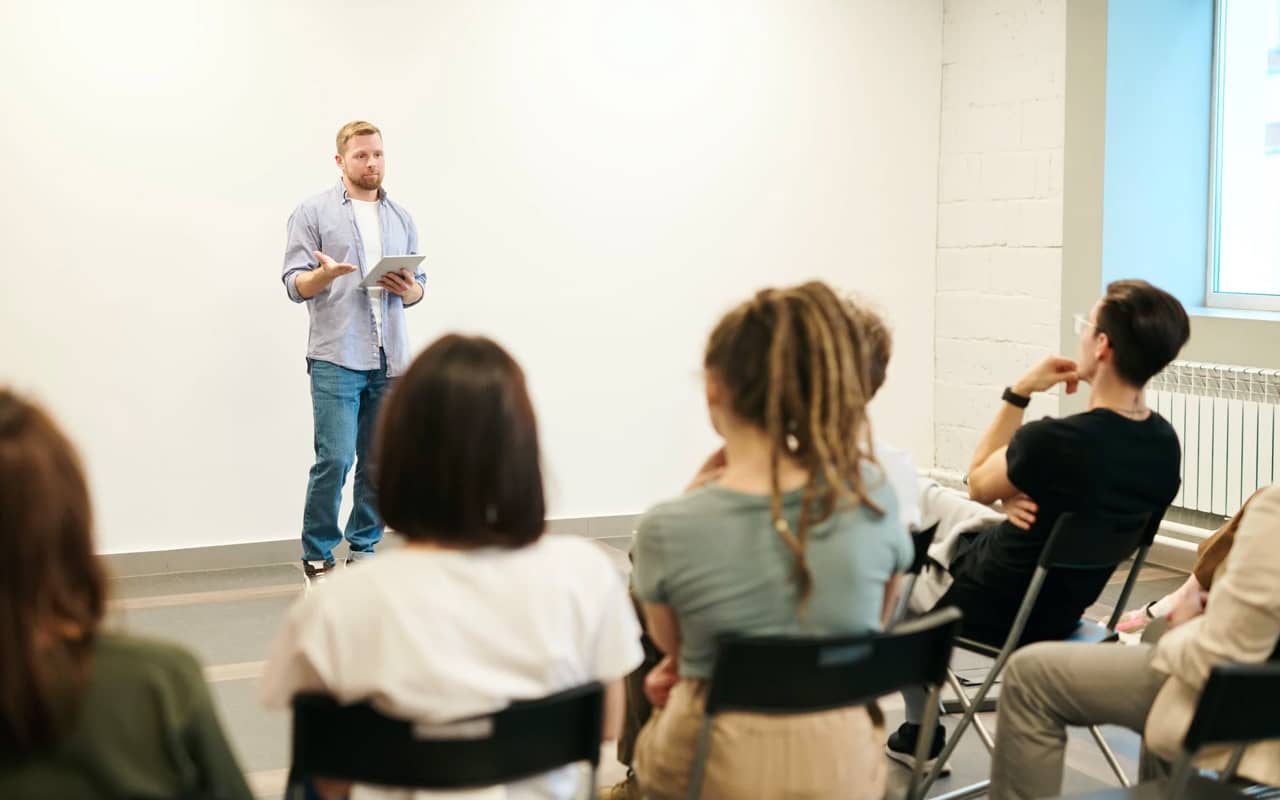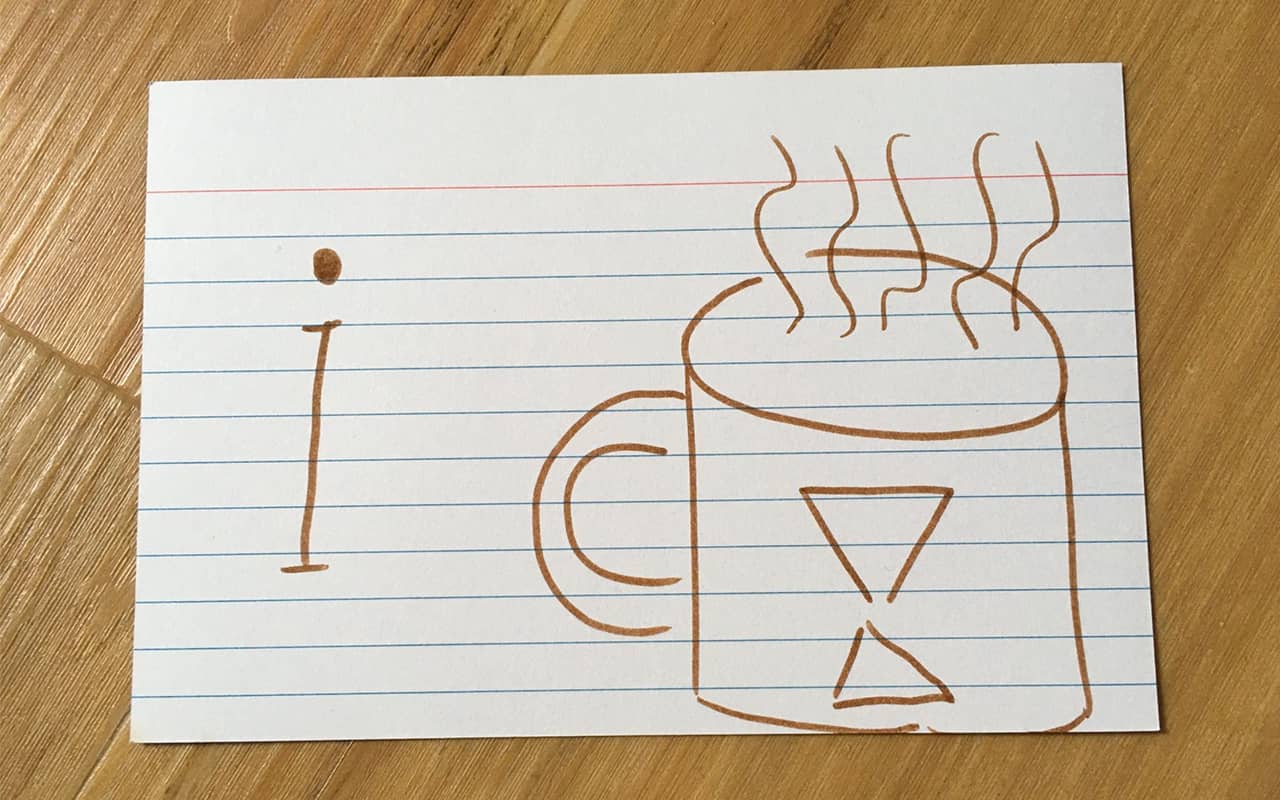Podcast: Download
Subscribe: Apple Podcasts | RSS

- Set a micro‑goal (e.g. “hold a 3‑minute café chat in 30 days”).
- Develop familiarity with the sounds & script before any of the other steps
- Build a core vocabulary by memorizing your first 50 mission‑critical words using the Memory Palace technique.
- Practice the “Big 5” skills of language learning daily:
- Memorize new words and phrases
- Speak
- Read
- Write
- Listen
- Get feedback and reiterate weekly to test your progress and get corrections from at least one native speaker.
Stick to this loop for 15 minutes × 3 sessions a day and you can hit A2 in approximately 90 days.
That’s exactly what I did to pass A2 when I lived in Germany.
I did it again to pass level III in Mandarin in an even shorter period of time.
Of course, there’s a bit more nuance to each of these steps.
And that’s what I’m going to share with you on this page
We’ll go through each step in detail and you’ll learn fourteen additional best practices used by the world’s most accomplished language learners.
Ready?
Let’s dive in!
How To Learn A Language in 5 Steps
Step One: Set a Micro Goal
Having taught people how to improve their memory so they can learn languages faster, I’ve noted one major trend.
Many people make language learning hard on themselves by having an “all or nothing” attitude.
In reality, languages are learned with much greater ease by using what scientists call chunking.
This term means that you break a learning task down into the smallest possible unit.
Many people start by learning how to say hello, please and thank you in their target language.
Once you complete that simple goal, you set another goal. Or as I sometimes prefer to think of them, “missions.”
How to Set Language Learning Goals You’ll Love Completing
When I first started learning German seriously, my classes at the Hartnackschule in Berlin provided these small missions.
Later, I had to provide my own language learning missions.
To do this, I asked one simple question:
“What do I want to be able to speak about next?”
My choices will differ from yours.
But to give you some examples, I played in a band at the time. So I chose music-related topics to help fashion my goals.
I also taught Film Studies at the University of Saarland, so regularly memorized words and phrases related to this industry.
Finally, I love asking philosophical questions, so I learned how to ask them in German.
A2 was passed quite easily. That’s because the courses I took told me what I needed to learn.
But it was crafting my own missions that got me fluent. Because I spent time working out what I wanted to talk about.
And now you know how to create your own goals and missions too.
Step Two: Develop Familiarity with the Sounds and Script of the Language
Before diving into memorizing words or grammar rules, it’s helpful to get comfortable with how the language looks and sounds.
For example, I took a phonology course for that when I first started learning German. Likewise with Mandarin further down the road.
It’s also useful to learn the International Phonetic Alphabet. This set of symbols will help you with pronunciation, which is essential to being understood.
It’s also important to immerse yourself in the rhythms of the language. You can easily do this by:
- Watching YouTube videos
- Enjoying popular movies in the language
- Listening to audiobooks
Even if you don’t understand much yet, this passive exposure will help your brain attune to the phonic features of the language.
Learning Writing Systems
Depending on the language, you may need to learn an entirely new writing system.
I had to do that with Mandarin by learning the hanzi.
For Japanese, I also had to spend time using memory techniques for the hiragana, amongst other character sets.
Each alphabet will propose different levels of challenge depending on your experience.
If you have any concerns, especially if you have limited time, it’s worth considering my article on the easiest languages to learn.
You don’t want to rush, and some languages simply require more from your brain’s ability to associate sight and sound.
The point is that you will want to develop this kind of sensory familiarity between sound and sight to reduce mental friction later.
Your brain will stop having to ask, “What is the sound of this symbol?”
As a result, you’ll be free to focus on memorizing more vocabulary and phrases without interruption while studying.
Step Three: Build a Core Vocabulary
Once you’re familiar with the sounds and script of your language, it’s time to start building your vocabulary.
You’ll want to start small based on the goal-setting process and chunking we discussed above.
There’s lots of advice people give about organizing vocabulary by category and using word frequency lists, but I stick personally to the missions to work out what words I need to focus on.
That’s because taking classes and learning with native speakers does a lot of the organizing.
Using Memory Techniques for Language Learning
Given that you know how to create goals, let’s talk about getting your first round of vocabulary into your long-term memory.
Learning to use memory techniques for language learning well is one of the best ways to rapidly accelerate your practice. Mnemonics help because:
- The Memory Palace technique allows you to rapidly scale the number of words and phrases you can remember
- Effective association through multi-sensory visualization makes words and meanings incredibly “sticky”
- Using the method of loci mentally replicates spaced repetition software without sacrificing the benefits of active recall
In fact, the memory techniques optimize how you practice recalling information in a way that strengthens your memory overall.
Step Four: Practice the Big Five of Language Learning
In order to create momentum and progress, it’s important to balance multiple levels of processing everything involved in learning and using your chosen language.
To do that, you’ll want to learn the major “meta learning” skills that make achieving fluency possible.
These activities can be broken down into what I like to call The Big 5 Of Language Learning. I’ve illustrated them for you with this diagram:
These five elements are based on a scientific principle called the “levels of processing”
How do I know they are valid?
Because researchers continually confirm their value in research papers like this one about Stephen Krashen’s input theory.
How the “Big Five” of Language Learning Works
And as the illustration above shows, giving yourself enough exposure to achieve the levels of processing effect requires you to combine:
- Memory
- Reading
- Writing
- Listening
- Speaking
It’s not a question of which one of these learning activities is most important.
It’s the holistic combination of all them that matters in the end. When I start a new language, I put each and every one of these activities into a learning cycle and interleave between them.
So far, only Hebrew, Sanskrit and Chinese have put speed bumps in my path. That’s because I had to learn their character systems first. But thanks to memory techniques, that didn’t take long.
Once you can read the language of the alphabet you’re dealing with, there are effective ways to combine listening and reading. You can do that by combining certain tools, like setting up subtitles on Netflix or the story narration program.
I feature both of these options on my best language learning software post.
You can also get great writing practice at the same time you speak, by repeating what you put on the page verbally either before or after putting it down on paper. These days, you can also explore language learning with chatGPT, which I’ve found helpful in small doses.

Any decent language learning class will make you go through these steps, but if you don’t also get yourself to do it on your own, you’ll struggle to learn your language.
Step Five: Get Feedback by Learning with Native Speakers
Learning in isolation is possible.
For example, I’ve achieved a lot in Latin purely by studying on my own.
But for most of us, it only gets us so far.
Why?
Because language learners need feedback.
And when you meet regularly with native speakers, you get instant feedback.
Please don’t wait to get started. Speaking before you’re “ready” is a key strategy and provides you with one of the fastest ways to improve.
You can watch me put this into practice in this video with me and my Ukrainian teacher during our very first lesson:
What’s the best way to find native speakers?
- Join a language exchange forum or website
- Schedule a call with a professional teacher and use Zoom (like you see in my Ukrainian learning documentary video above)
- Find a local tutor through a school or by placing an ad
Even just 10-15 minutes of interaction a few times a week can reveal gaps you’re not aware you have.
I suggest recording every session and then applying memory techniques later.
When you combine speaking with each of the other Big Five language learning activities, you’ll lock vocabulary, phrases and grammar principles into long-term memory effectively.
And you’ll build confidence as you go, which leads to competence in the language.
The Best Practices That Get Languages Learned Faster
Now that you have my five best steps under your belt, let’s talk about some best practices.
These suggestions are based on my years of experience interviewing and being friends with some of the world’s leading polyglots.
Their advice has helped me so much and I’m confident these considerations will help you achieve fluency too.
Best Practice One: Develop A Positive Mindset
So many people ask, How hard is it to learn a new language?
But what if this is the wrong question?
What if a better question is: what are the mental strength resources I need to keep consistent over the long term?
When it comes to language learning, you’ll want to develop skills with:
- Setting realistic goals
- For example, if your language has a character set or new alphabet you need to learn, this might be your first goal.
- If you already know the alphabet, then your first goal might be how to introduce yourself, plus fifty new words related to some of your interests.
- Creating a practical schedule.
- Showing up consistently.
- Managing your expectations.
- Understanding the different types of motivation when learning languages.
- Accept that mistakes will be made and be willing to learn from them.
- Exploring and acquiring the best language learning materials.
- Developing the courage to speak the language.

Some people will need to spend more time learning these skills than others. But they can all be learned and improved as you go.
Best Practice Two: Choose The Best Possible Language Learning Materials
This step is tricky, but also very doable.
First, just accept that some risk is involved. You might end up buying a book or course that just doesn’t suit you.
This circles back to mindset, particularly managing your expectations.
Personally, I treat it all as research and don’t get emotionally involved.
In fact, I allow myself to be open to revisiting any resource I’ve purchased again in the future, because we as humans can be tremendously fickle. It might not be that the book or course is bad. It’s entirely possible that we were either not ready for it yet, or just having a bad day, week, month or year.
A subset of choosing the best materials for learning a language is to limit the amount of sources. When learning a language, we do want tons of input – but that doesn’t mean you want it from dozens of sources.

Instead, I suggest you take a tip I’ve benefited from. It comes from my friend and language learning expert Olly Richards, who advises that we pick at maximum:
- One book
- One video or audio program
- One teacher
By sticking to limits like these, we give ourselves ample opportunity to experience the levels of processing effect while not overwhelming ourselves with materials. Embracing limits helps us maximize our investment in the materials and enjoy the benefits of thoroughness.
Plus, if you’re going to use rote learning instead of memory techniques, the limits will help ensure the rote is concentrated and not spread across too many different sources.
When it comes to avoiding rote, Olly shares some fantastic advice in this podcast:
Again, whether you use rote or mnemonics, you might find you acquire materials that simply don’t work. It happens, but at least you’ll have learned something about language learning materials that don’t suit your needs.
But overall, you can limit this problem in the first place my limiting how many language learning guides you bring into your learning life in the first place. And making sure that you always maximize your thoroughness with the ones you do choose.

That way, time will erase any mistakes and the materials you learn from will pay off soon.
My personal rule of thumb is to stick with a book, course or audio program for at least 90 days.
When I was learning Chinese, for example, I followed my own advice. By working with just one audio program, one book and one teacher, this limited focus helped me achieve much faster progress.
But had I been by constantly throwing new “shiny new textbooks” in my path, I would have been constantly distracted.
Need a source for good language learning teachers online? These days I suggest you give Languatalk a try.
Best Practice Three: Immerse Yourself With Sensible Input And Strategic Challenges
In the beginning, you might not understand anything. But as you learn, your pattern recognition will go up.
There are a number of ways to keep increasing your sensible input. These include:
- Meet regularly with a native speaker
- Be sure to bring a picture-based magazine. Learn to ask, “What is that?” and keep pointing at pictures. Record the sessions with your smart phone and listen back, trying to guess what you were looking at in the magazine.
- Watch movies with subtitles
- When you find vocabulary and phrases you want to learn, write them down and memorize them. I recommend you create your own flashcards by hand using drawings and colors, like this:

- Complete courses and textbooks thoroughly
- These will help increase the amount of patterns you’ll recognize as you continue your exposure to the language you’re learning.
- Read short stories and news articles
- You can do this by just reading or by creating your own translations as you go. My friend Luca Lampariello shares a number of tips on how to use translation to increase your fluency.
- Take a course
- Strictly speaking, taking a course isn’t necessary. I’ve done it both as a beginner and as a more established student and find saving it for later much more useful.
- If you take a course, make sure the teacher uses the target language primarily. You’re not there to improve your mother tongue or teach it to them.
- Speak with natives online
- There are many great websites for finding people to speak with during dedicated sessions or in small doses by sending and receiving audio texts.
- As a rule of thumb, I like to give new speaking partners 2-3 sessions before deciding if they are a fit or not.
- There are many great websites for finding people to speak with during dedicated sessions or in small doses by sending and receiving audio texts.
- Follow Instagram and other social media accounts in your target language.
- Learn songs in your target language.
I know that it can seem strange that learning songs will help, but it helps get more vocabulary and grammar in memory than you might think.
It’s fun too, as you can see as I practice singing a song in Mandarin I later performed at my wedding:
With all of these learning activities, you need to use your judgment. If you go for something too advanced, you’ll just get frustrated.
By the same token, if you don’t challenge yourself, you’ll quickly get bored. Get out of your comfort zone. It’s where you’ll find the progress you seek.
Best Practice Four: Invest Enough Time For Daily Practice (But Not Too Much)
People think you have to spend five to six hours a day while learning a language. This just isn’t true.
By the same token, you’re not going to get very far with just 5 minutes a day.
That said, if you’re strategic about it, you can learn a lot in 15-30 minutes a day. The trick is in breaking up the activities and making sure you’re getting in enough practice of all The Big 5.
A schedule like the one I’ve drawn up for you in the following example can work wonders:
- Mornings: 15 minutes memorizing vocabulary
- Afternoons: 15 minutes of reading and listening using narrated short stories or news articles
- Evenings: 15 minutes watching a movie (or the whole movie with about 15 minutes spent capturing words and phrases you find interesting)
Then, the next morning, you can memorize the new vocabulary you’ve gathered from the day before.
The exact amount of time you spend is not nearly as important as the consistency and focus you bring to each learning session.
Also, vary the routine. If the routine I suggested is something you use on Mondays, Wednesdays and Fridays, do this on Tuesdays and Thursdays:
- 30 minutes in discussion with a native speaker
- 30 minutes reviewing the discussion recording
It’s also important to schedule breaks. Taking a week off once in a while actually does your brain good when you’re learning.

The trick is making sure you don’t take off too long and then struggle to get back on the horse.
Here’s a simple tip:
Make sure your language learning sessions with speaking partners are booked in advance. That way, you’re taking some highly beneficial time off, but not with a dangerous open end.
If you still struggle with developing a personal schedule for language learning, give mind mapping for project planning and scheduling a try. I’ve found it useful during times when I was struggling to organize my time.
Best Practice Five: Build Your Own Vocabulary And Phrase Lists
Many people ask, “How long does it take to learn a new language?” I believe the answer should be that the journey never ends.
But for those who are in a hurry, they often come across the idea of “frequency lists.”
These are compilations of words that are used the most often in any given language. If you’re learning Spanish, these lists can be especially seductive.
And they definitely can be useful. In some cases, they will accelerate how quickly you can get started learning the language.
However, they’re also incredibly limited.
Why?
Because no maker of such lists can know what contexts you’ll find yourself in or what you’re going to want to talk about.
That’s why when you’re reading news stories and translating them, it’s important to focus on information that’s interesting and relevant to you.

You’ll move along so much faster if you let yourself be informed by word lists, but also always take care to build your own. There are no “right” words to focus on and true fluency comes from being able to accomplish missions.
When learning German, my favorite way to produce my own custom lists was to read interviews with musicians. They use so many interesting words and turns-of-phrase. It really helped me add interest and flair to how I use the language.
Likewise in Mandarin, I’ve learned a lot from the hip hop scene. They use a lot of interesting phrases that are not only useful, but also add character to my use of the language.
The point being that the more you build your own list of words and phrases you want to know, the more make your connection to the language unique and feel a lot more special.
Best Practice Six: Focus On Systems As Much As, If Not More Than Goals
Goals are important. But even more important are the systems that help ensure that you actually accomplish your language learning goals.
Let’s say your goal is to learn 50 new words by the end of the week. Great! That’s perfectly realistic.
But it’s also meaningless if you haven’t sat down and charted out a systematic means to ensure you memorize those words.
I suggest developing an if-this-then-that language learning habit stack.
For example, let’s say you’ve developed a Memory Palace strategy and you’ve spent some time gathering the words you want to memorize. Your habit stack might look like this:
- If I wake up, I go immediately to my learning place.
- If I go to my learning place, I open my Memory Journal to the list of words I’ve prepared.
- If I have my list, I start with the first word and memorize it using Station One of the Memory Palace.
- If I have memorized one word, I move on to the next.
- If I have memorized 10 words, I put my Memory Journal away and start mentally reviewing the words.
- If I have reviewed my words 3-5 times during the day, I test by writing them out by hand and speak them out loud.
This is a little system that drives you towards completing the goal. And if you do something like this every day, by the end of the week, you will have memorized 50 words.
You might think even something as tight as this set of steps will take a long time. But nothing could be further from the truth. Once you get the hang of it, you’ll wonder how you ever lived without such a simple and elegant system.
Best Practice Seven: Use The Language Every Day
Have you learned only one word so far?
No problem. Use it.
Or do you have only a few hundred words?
The principle is the same. Use what you’ve got.
Talk to yourself as you’re walking down the street.
Tell other people about the phrases you’ve learned and repeat them.
Sing songs in the language you’re learning.
Make your shopping lists in the language you’re learning instead of your mother tongue.

You need to get the words into the muscle memory of your mouth and your mind.
If you dedicate yourself, everything from brushing your teeth to tying your shoes and kissing your loved ones to sleep at night are excellent opportunities to practice.
Best Practice Eight: Use History And Culture As Your “Secret Weapons”
As I’ve been learning German, Chinese and Sanskrit, I’ve made sure to not stop at the language itself.
Reading novels, books of history and philosophy from the cultures not only gives you more exposure to the language. It helps you understand the historical and cultural forces that shaped it throughout history and continue to exert an influence.
I would also include serious study of geography and topics like social science.
Knowing about the region can help you understand a lot about how the language developed, and understanding issues related to psychographics can help you fall in love with certain matters of grammar.
This latter point is important because a lot of people waste time trying to understand the “why” of grammar instead of simply accepting it for what it is.
That said, John McWhorter has shared some compelling reasons to believe that our language differences don’t distinguish us psychologically as much as we might believe.
These are interesting points to consider, and all arrive at the same benefits for you:
When you immerse yourself in the culture and its history, you’ll have more things to talk about with native speakers.
This point is especially important if you’re introverted or generally shy. But read widely and you’ll never be at a loss for conversation topics.
Best Practice Nine: Don’t Take Yourself Too Seriously
A lot of people get hung up on little things when learning languages. They become perfectionists, without realizing that you need to make mistakes in order to learn.
Develop the ability to laugh at yourself. If you struggle with self criticism, learn these Two Easily Remembered Questions That Silence Negative Thoughts. I’ve learned them in both English and Sanskrit, and that has been tremendously useful.
And rest assured, the kind of mindfulness that I’m suggesting you adopt has been formally studied for foreign language learners. As this researcher found, people who meditate get better results when learning languages.

Another part of mindfulness involves how you manage your teachers and speaking partners. For example, if a teacher is frustrating you by correcting you too often, ask them to scale it down.
When I submit writing to language teachers, I ask them to please point out just three errors. That way I can keep things light and fun and focus on the biggest aspects to improve without overwhelm.
But if you meet people who can’t help you or make the journey too serious and destroy all the fun, find someone else. There are plenty of fish in the sea.
Best Practice Ten: Use “Chorusing”
Let me be honest with you:
Pronunciation has always been my biggest struggle when learning languages. It could be genetics. I’ve been tone deaf my entire life.
Yet, I have managed to learn to play multiple musical instruments and a few languages.
Time and time again, I always wish I focused more on pronunciation.
Enter a concept called “chorusing” that I learned from my friends at Outlier Linguistics.

In brief, this technique is the audio version of using flash cards.
Using recording software like Audacity, you record a native speaker speaking a word or phrase. Then you copy and paste it multiple times so you can hear it repeated and really dig into the nuances.
Next, you record yourself speaking it on a separate track.
Since a good audio recorder will let you see the sound waves, you can try to make your voice match certain characteristics visually.
But the more important aspect with this technique is you are training your ear to hear yourself and correct your pronunciation through direct comparison.
The time investment on this technique is admittedly intense. But it’s well worth the effort, especially if this is a weak point for you as it is for me.
Another way to memorize pronunciation is to learn the IPA (International Phonetic Alphabet). To do that quickly, I drew my own flashcards with striking images that remind me of the sound I’m supposed to make when looking at the symbols.
Check out the card above, for example.
The “i” is a symbol that indicates a long “e” vowel sound. That is also indicated by the two empty triangles I’ve drawn on the coffee cup.
Why a coffee cup? Because an example of the long “e” is in the word “bean.” Coffee reminds me of beans and that’s how I learned to read this symbol when looking at the IPA pronunciation guide.
The other way to remember pronunciation is to simply speak and listen as much as possible. You might feel like you have to go beyond the call of duty in this department, but if you really want to learn a language, the needed amount of exposure should be a non-issue.
It’s best to focus on one language at a time, however. Certainly you can learn two languages at once, but for most of us this is only going to be practical if we have time for enough speaking and listening practice in each language we focus on.
Best Practice Eleven: Use Cognates But Beware Of “False Friends”
Many languages have words that are the same or very similar.
In Spanish, for example, you’ll find thousands of words that are very close in sound and meaning to their English equivalents. You might also see these words referred to as “loan words.”
However, there are also a number of false cognates that mean very different things.
Always check so that you don’t wind up creating foundational errors that may be difficult to correct later.
Best Practice Twelve: Add Another Language After You’ve Earned The First One
It’s normal to want to be a polyglot, or someone who speaks 3-5 languages well. But as far as I can tell, all the successful polyglots got there by being willing to establish mastery in just one language at a time.
Once you’ve done that, you will be very well-versed in the meta learning skills that will help you proceed in leaps and bounds towards substantial speaking and understanding abilities.
And then you can do cool things like what my friend Benny Lewis calls “laddering.” This technique is when you pick a textbook or course in a language you’ve already learned to start covering the next one.
For example, most of my sources of material for learning Chinese have been from books written in German.

One exception to this suggestion that some people find useful is to spend some time learning Esperanto.
The reasoning here suggests that Esperanto is especially suited to helping learners understand more about how different languages work.
Frankly, I’m not convinced you have to become a grammarian or linguist in order to become fluent in a language. If anything, the world is packed with people who are experts in those topics who can’t even speak one other language.
But if you’re still stuck, it might be worth looking into Esperanto for these reasons.
Or, you could look at a root language to see if it helps wake up your brain.
For example, a small amount of time learning Latin can open up Spanish or Italian for you to an incredible degree.
However, at the end of the day, the old saying that the hunter who chases two rabbits rarely catches either stands up here. Split your attention between more than one language only at great risk.
Best Practice Thirteen: Travel If You Can, But Don’t Make It A Must
I’ve been lucky and was able to spend years of my life in Germany. During that time, I made sure to live with people who spoke little or no English to make “total immersion” something from which I could not escape.
But I didn’t have the luxury of living in China when I first started learning the language. And it was absolutely not necessary.
In fact, after less than 3 months of studying the language, my time in the country was so distracting, I didn’t have time to study it at all. And that is typically what happens when you try to combine tourism with immersion.
Instead, use the tips on this page to create proper goals and the effective systems that will place you in the company of your target language each and every day.
Then, when you do get to travel, you can relax and focus on speaking and understanding much more around you. You’ll have earned it.
Best Practice Fourteen: Give Grammar its Proper Place
You can definitely use memory techniques to help you learn grammar.
However, grammar does not need to be mastered before you start reading, writing, speaking and listening.
In fact, it never needs to be mastered at all.
Instead, it’s best to keep reviewing it and learning it in context as you go.
We have to do this in our mother tongue as well and grammar guides are sometimes updated as languages change over time.
So focus on how the language is used in your target language rather than focusing too much on isolated rules.
Often those rules are useful in language learning classes. But in real life, you’ll find that there are many exceptions to the rules.
Learn to absorb how a variety of people use the language so you can use the grammar naturally and intuitively.
Quick Language Learning FAQ
I’ve been blessed to help many language learners over the years.
These are the questions that I’ve seen the most since I started teaching memory techniques for language learning in 2012 following the publication of my first book, How to Learn and Memorize German Vocabulary.
How long does it take to learn a new language to A2?
Many people reach A2 in about 90 days. The amount of time you need might vary, but start by studying 45 minutes a day across three sessions (fifteen minutes each).
Focus on core vocabulary, daily practice with the Big Five skills, and consistent feedback from native speakers.
Should I learn grammar first or vocabulary?
Start with vocabulary.
You’ll absorb grammar more naturally through reading, listening, and speaking.
Use memory techniques to learn sentence patterns in context instead of memorizing isolated rules upfront.
Can I learn two languages at the same time?
It’s possible, but not ideal for most learners.
Split focus usually slows progress. Master one language first—then use it as a base (laddering) to learn your next language more efficiently.
Do I need to travel to learn a language?
Not at all. While immersion helps, you can create your own immersion at home using Memory Palaces, native speaker sessions, media in the target language, and goal-driven study systems.
In fact, sometimes traveling to learn a language can be a distraction. It made sense for me to study German in Germany only because I was already living there.
What’s the fastest way to remember new words?
Use the Memory Palace technique. The process is worth learning because it creates stronger neural associations and dramatically improves retention.
And don’t worry about not having enough Memory Palaces or that you won’t be able to learn enough words.
As you gain experience with the technique, you’ll soon realize that your memory has plenty of space.
And you’ll see how the Big Five of Language learning works as a spaced repetition process that allows you to focus on getting a lot of learning done as you memorize fewer new words over time.
The Best Ways To Learn A Language Begin And End With You And Your Strategy
A lot of people think that kids have some special advantage when it comes to learning a language. This couldn’t be further from the truth.
In reality, kids take years to speak proper sentences, and many more to read and write at a sophisticated level.
But because adults have all kinds of skills in their mother language, impulse control and the levels of discipline needed to make it on the job market, you have a distinct advantage.
You really just need to bring everything you know about being a mature and responsible adult to the process of learning a language. But that doesn’t mean you don’t bring childlike curiosity and fun to the game.
The benefits of speaking a language are immense, ranging from higher salary to the brain health benefits of bilingualism.
And if you’d like more help with the Memory Palace technique we discussed above, you’re welcome to grab my free course:
It gives you four video tutorials and three worksheets that will get you up and running.
So what do you say?
What language do you want to learn and are you feeling empowered now that you have all of these steps and powerful best practices for learning it?
Related Posts
- Memorizing Short Texts To Learn Your Foreign Language Faster
This tip will help you pick up foreign language vocabulary fast ... assuming you're using…
- The Freedom Journal For Language Learning: The Ultimate 10-Step Guide
Have you ever thought about using a journal to help you be more accountable as…












4 Responses
honestly, I have no words what to say, teacher, its great to have you. I got lucky because I found the right teacher . You are a language terapist, i am sure my speakig dream will come true if i walk with you. You have shared with me your knowledge and the tricks I have to know in learn English. I have found it helpful. The tricks Which you have shared us are very realistic. You enlightend my confusion. I sometimes watch lessons on youtube which says, 20 phrases that can help you speak like natives. I watched it to the end but I couldn’t speak like natives. This is not true, teachers on youtube use systems to watch their lesson. Learning is a long life process. Now you tell me I should set a goal. If its vocabulary in 10 days, then I have to focus and achive that goal then the other day, i have to do the same thing. step by step journey I will speak like nayives Thank you. I have fond your tips and tricks very useful. Thank you once again.
Thanks so much for letting me know that you found it valuable.
There’s all kinds of advice out there, but often the people who are giving it haven’t actually done the work. Or if they have, they’re dumbing down the real steps that are involved.
I never want to do that so thank you very much for supporting this effort with your comment. I look forward to more feedback from you on my other posts as your time allows.
If I set goal to have basic conversations like greetings, and introducing myself and also ask about their conditions. So my 50 core vocabulary from korean language should be about greetings and those things right? Because I’m a little confused about choosing the core vocabulary part. And also should I memorize the 50 core vocabulary first or the basic hangeul alphabet first?
50 words is given as an example. If your goal requires more or fewer words, you can shift the exact number.
Does this way of looking at things make sense and help you out?